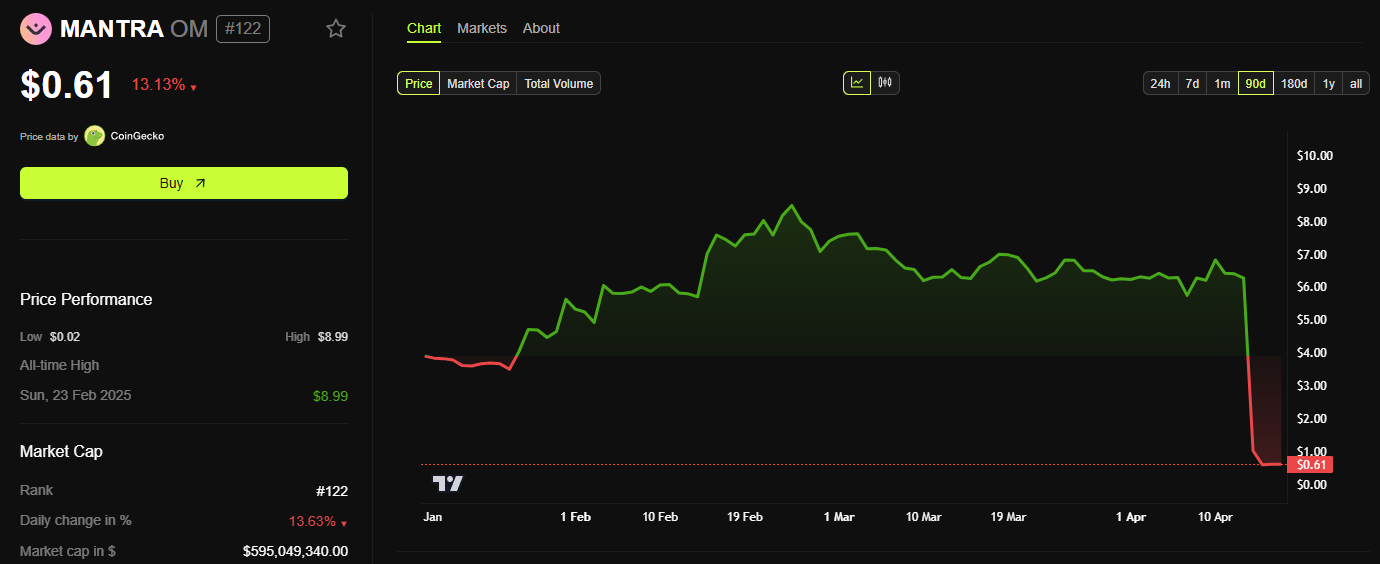Mantra’s 90% Crash Sparks Allegations of Collusion Between Market Makers and CEXs
0
0

On April 13, the price of the Mantra (OM) token plummeted from $6.30 to below $0.50, marking a loss of over 90% in a single day. This event wiped out more than $6 billion from Mantra’s market cap and shocked the crypto community.
Many believe this wasn’t a random market movement. Instead, they suspect it was a well-orchestrated “pump-and-dump” scheme involving market makers and centralized exchanges (CEXs).
Are Market Makers And CEXs Working Together to Harm Investors?
According to investor Anon Vee, the Mantra collapse is a textbook example of a pump-and-dump strategy. He explained that market makers often target lesser-known tokens. They team up with projects to artificially inflate the price, then dump the tokens to take profit.
He compared Mantra to Tellor (TRB), which surged from $6 to $629 during 2022–2023 before crashing. Similarly, Mantra rose from $0.013 to $9, pushing its fully diluted valuation (FDV) from $20 million to $11 billion before crashing back down to around $0.4978.
“Do you really believe the Mantra pump and dump wasn’t planned?… It works best when the insiders control most of the supply,” Anon Vee said.
Crypto influencer Leonidas shared the same view. He accused centralized exchanges like Binance of playing a key role.
According to him, Binance helped promote OM, creating hype to attract retail investors. But once the price peaked, market makers and CEXs allegedly dumped their tokens, causing the crash and leaving retail investors with heavy losses.
“CEXs (like Binance who promoted it in 11 posts) teamed up with market makers to pump the price up, lure in retail, then they dump on your face. That is the only truth,” Leonidas stated.
One investor even revealed that they had invested $3.5 million into the RWA OM token. That investment is now worth only $200,000—a drop of over 90%.
Arthur, founder and CIO of DeFiance Capital, also voiced concerns about liquidity issues in the crypto market. He warned that project teams and market makers often cooperate to maintain artificially high prices over extended periods to deceive investors.
He stressed that this practice distorts a token’s real value and creates serious risks for the entire market. Arthur called for more transparency and stricter oversight to protect investors.
“The biggest problem plaguing the liquid crypto market now is the complete black box of how projects and market makers can work together to create an artificial price that can sustain for a very long period… If the big players in the industry don’t step up to improve this, large part of the market will remain uninvestable for foreseeable future,” Arthur warned.
Investors React Differently to Mantra’s Explanation
John Mullin, co-founder of Mantra, publicly denied the insider trading allegations. He claimed the collapse resulted from “forced closures” by certain centralized exchanges. According to him, the incident happened during a low-liquidity period—specifically on a Sunday night—which worsened the situation.
Mullin hinted that one specific exchange was primarily responsible, but he insisted it wasn’t Binance.
Despite his explanation, the community questioned whether this was merely an excuse to cover up deeper problems within the project. Regardless of Mantra’s statement, many investors believed that a crash of this scale could only be caused by a market maker.
“In this case, someone big decided that they wanted out and did not care that the price will be impacted. This crash is either a market maker going rogue or some insider deciding he wants out and sold beyond available liquidity. When this happens, the market maker will also pull out his liquidity since nobody wants to burn more money,” Investor Duo Nine explainted.
At the time of writing, OM is trading around $0.60—down more than 90% from $6 just two days ago.
 Mantra (OM) Price Performance. Source: BeInCrypto.
Mantra (OM) Price Performance. Source: BeInCrypto.
Nevertheless, some investors saw the crash as an opportunity. For example, Carl Moon, Founder of Moon Capital, decided to buy $100,000 worth of Mantra (OM) after the price drop.
0
0
 Manage all your crypto, NFT and DeFi from one place
Manage all your crypto, NFT and DeFi from one placeSecurely connect the portfolio you’re using to start.








